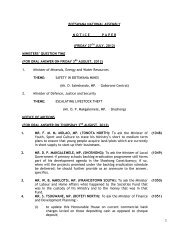National Nutrition and HIV/AIDS Guidelines for Service Providers of ...
National Nutrition and HIV/AIDS Guidelines for Service Providers of ...
National Nutrition and HIV/AIDS Guidelines for Service Providers of ...
Create successful ePaper yourself
Turn your PDF publications into a flip-book with our unique Google optimized e-Paper software.
provide fiber. Nutrients found in vegetables play major roles in enhancing body processes <strong>and</strong><br />
improving the immune function. Vegetables also provide color, flavor <strong>and</strong> pleasing texture to meals. It<br />
is important that a diet provide a wide variety <strong>of</strong> vegetables because each family <strong>of</strong> vegetables is<br />
uniquely rich in some vitamins <strong>and</strong> minerals <strong>and</strong> not others. Thus, the provision <strong>of</strong> a wide variety <strong>of</strong><br />
vegetable in the diet over time will ensure that the diet consumed is adequate in most minerals <strong>and</strong><br />
vitamins.<br />
Vegetables also provide plant based compounds <strong>of</strong>ten referred to as phytochemicals. The<br />
phytochemicals are known to have health promoting properties in the body. Some phytochemicals have<br />
been known to lower the risk <strong>of</strong> cancer, to lower blood cholesterol, to improve the immune functions<br />
<strong>and</strong> confer other protective properties to the body. As with vitamins <strong>and</strong> minerals, different<br />
vegetables provide different phytochemicals.<br />
Both indigenous <strong>and</strong> non indigenous vegetables are important in the diet <strong>and</strong> should there<strong>for</strong>e be<br />
equally provided in the diet. It is recommended that 3-5 servings <strong>of</strong> vegetables should be included in<br />
the diet each day. Apart from the nutrients they provide, vegetables also provide color <strong>and</strong> flavor.<br />
Careful selection <strong>and</strong> preparation <strong>of</strong> vegetables can make the food more appealing to eat even to those<br />
people with depressed appetites.<br />
Examples <strong>of</strong> indigenous vegetables include morogo wa dinawa, rotho, leketa, thepe, delele,<br />
lerotse/lekatane, makgomane, magabala <strong>and</strong> maphutshe. Fresh, frozen, dried <strong>and</strong> canned vegetables<br />
all count. Refer to table 2.1 <strong>for</strong> more examples <strong>of</strong> vegetables.<br />
Nutrients in vegetables can easily be lost if vegetables are over-cooked, cut into small pieces during<br />
food preparation, or exposed to excessive sunlight. Nutrients can be preserved by cooking vegetables<br />
<strong>for</strong> a very short time (should taste crispy) <strong>and</strong> re-using liquor that might be left over <strong>for</strong> other dishes.<br />
Most people should EAT MORE vegetables than they are presently eating.<br />
2.3.3 Fruits<br />
Just like vegetables fruits provide vitamins <strong>and</strong> minerals. They are rich in Vitamins A, C, potassium,<br />
fiber <strong>and</strong> phytochemicals. On average most people do not eat enough fruits. It is recommended that 24<br />
portions <strong>of</strong> fruits be consumed each day. Altogether, 5-9 servings <strong>of</strong> fruits <strong>and</strong> vegetables should be<br />
included in the diet each day. As with vegetables, both indigenous <strong>and</strong> non indigenous fruits are<br />
valuable <strong>and</strong> should be deliberately included in the diet. In addition, nutrients in fruits can easily be<br />
lost. This can be avoided by using fruits immediately after peeling them <strong>and</strong> not leaving peeled fruits<br />
exposed to air.<br />
Examples <strong>of</strong> indigenous fruit include mmupudu, mmilo, moretlwa, morula, moretologa,<br />
mogorogorwana, mmurubele (mulberry). Other fruit are banana, orange, apple, pear, guava fruit, etc.<br />
Fresh, frozen, dried <strong>and</strong> canned fruit all count. Also, 100% fruit juice <strong>and</strong> pure fruit juice smoothies<br />
count.<br />
Most people should EAT MORE fruits than they are presently eating: 24 portions a day.<br />
Most people should be encouraged to<br />
o<br />
o<br />
o<br />
o<br />
o<br />
Choose fruits or chopped vegetables as a snack<br />
Add dried or fresh fruits to breakfast cereals<br />
Eat fruit or vegetable salads with s<strong>and</strong>wiches or with pizza<br />
Add vegetables to casseroles <strong>and</strong> stews, <strong>and</strong> fruits to desserts<br />
Eat different fruits <strong>and</strong> vegetables every day<br />
8

















